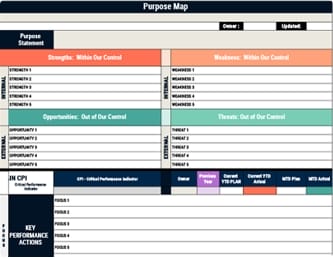You might think organizational alignment is just another corporate buzzword, but it’s actually a crucial process for any company aiming to succeed. It involves ensuring that every part of your organization works toward the same goals, harmonizing vision, strategy, and actions across all levels. By using frameworks like the McKinsey 7-S model or OKRs, you can establish clear objectives and foster collaboration, setting the stage for improved adaptability and effectiveness. Want to know how to implement these strategies effectively?
Key Takeaways
- Organizational alignment harmonizes a company’s vision with leaders’ and employees’ actions for cohesive functionality.
- It integrates strategy, structure, and systems to foster a culture focused on common goals.
- Frameworks like the McKinsey 7-S Model assess and facilitate organizational alignment.
- Effective communication and shared strategic goals enhance employee engagement and collaboration.
- Organizational alignment boosts adaptability and competitiveness in dynamic market environments.
Understanding Organizational Alignment
To truly understand organizational alignment, you must first recognize that it’s a comprehensive process of harmonizing a company’s vision with the actions of both leaders and employees, ensuring everyone moves in the same direction to achieve desired results.
Organizational alignment requires a strategic approach to integrating the company’s strategy, organizational structure, and systems, fostering a culture where common goals are prioritized.
Integrate strategy, structure, and systems to cultivate a goal-oriented culture.
Employee engagement and collaboration thrive when there’s effective communication, enhancing efficiency across the board.
Utilizing an implementation framework like the McKinsey 7-S model helps assess and align these elements cohesively.
Without alignment, chaos ensues, causing miscommunications and conflicting objectives.
Therefore, it’s crucial to maintain an efficient, collaborative environment to ensure all parts of the organization work seamlessly together.
Importance of Organizational Alignment
Recognizing the importance of organizational alignment becomes the next logical step after understanding its foundational principles.
It plays a critical role in enhancing overall business performance, as aligned organizations often see faster growth in revenue and profit.
Here’s why it’s crucial:
- Boosts Collaboration and Employee Engagement: When everyone works towards the same strategic goals, teamwork improves, leading to higher morale and productivity.
- Adapts to Market Changes: An aligned organization can swiftly adjust to new market dynamics, maintaining its competitiveness and agility.
- Minimizes Misalignment Issues: Clear strategic goals prevent inefficiencies and confusion, reducing mistakes and improving performance.
- Enhances Customer Satisfaction: With aligned organizational elements, you can better meet customer needs, fostering loyalty and satisfaction.
Emphasizing alignment is key to thriving in today’s dynamic business environment.
Key Elements of Organizational Alignment
While achieving organizational alignment, you must focus on several key elements that work together to create a unified approach toward common goals.
Start with an organizational alignment survey to evaluate your current standing. Incorporate strategy, shared values, and clear communication to ensure effective organizational alignment, directing everyone toward the same objectives.
Define roles and responsibilities clearly, enabling team goals to align seamlessly with the overall strategy execution. Foster continuous improvement by regularly revisiting these elements and adapting them as needed.
Establish feedback loops to encourage open dialogue, facilitating transparent communication and collaboration. This process not only enhances efficiency and reduces conflicts but also boosts employee engagement, ensuring everyone remains focused on the mission and vision of the organization.
Implementing Organizational Alignment Frameworks
Implementing organizational alignment frameworks is essential for creating a cohesive environment where everyone works toward shared objectives. One effective way to achieve this is by setting clear strategic objectives that reflect the organization’s long-term vision.
Setting clear strategic objectives is key to aligning efforts with the organization’s long-term vision.
Break these objectives into measurable key results to align departmental goals effectively. Continuous communication fosters understanding and synergy, while cross-departmental collaboration minimizes silos. Regularly assess performance data to adapt strategies, ensuring agility and responsiveness to change.
Utilizing frameworks like OKRs promotes transparency and accountability, streamlining goal setting across all levels.
Consider these steps:
- Define strategic objectives: Align them with the organization’s vision.
- Set measurable key results: Clarify departmental goals.
- Foster communication: Encourage collaboration across departments.
- Utilize OKRs: Enhance transparency and accountability.
Best Practices for Achieving Alignment
To achieve alignment within an organization, it’s crucial to establish clear and shared strategic goals that are communicated effectively to every team member, ensuring everyone understands their role in the broader organizational objectives.
Begin by defining these goals explicitly and promoting transparency to unify the team. Foster collaboration across departments to break down silos, encouraging shared accountability.
Implement a continuous feedback loop to assess performance, allowing your organization to adapt strategies based on data-driven insights. Regularly measure alignment through employee surveys and performance metrics to identify improvement areas.
This proactive approach ensures your strategy stays relevant, maintaining alignment amid changing business conditions. By prioritizing these best practices, you’ll drive both individual and organizational success towards achieving shared goals and objectives.
Communication and Adaptation in Alignment
Effective communication and adaptation are critical components in maintaining organizational alignment, as they ensure all team members are consistently informed and engaged with the strategic objectives.
To achieve this, you should focus on several key areas:
- Regular Check-Ins and Meetings: Schedule consistent check-ins and quarterly review meetings to discuss progress and address challenges, ensuring alignment with organizational goals.
- Structured Feedback Loop: Implement a feedback loop allowing real-time strategy adjustments based on performance data, ensuring continued relevance and alignment in dynamic environments.
- Resource Reallocation: Adapt based on performance data to effectively reallocate resources and revise strategies when growth expectations aren’t met.
- Open Communication Culture: Foster a culture of open communication to reinforce focus on organizational objectives, enhancing collaboration and productivity among teams.
Examples of Organizational Alignment Frameworks
When it comes to organizational alignment, various frameworks can significantly enhance your understanding and implementation of strategic coherence within a company.
The McKinsey 7-S Model, for instance, underscores interconnectedness through Strategy, Structure, Systems, Shared Values, Style, Staff, and Skills, ensuring every part of your organization is aligned with strategic plans.
Strategy, Structure, Systems, Shared Values, Style, Staff, and Skills ensure organizational alignment with strategic plans.
In a tech startup, embracing a flexible structure that reinforces core values and encourages collaborative efforts is crucial for rapid innovation.
Retail chains often integrate Customer Relationship Management systems to boost customer experience across multiple channels.
Meanwhile, healthcare facilities utilize electronic health records to streamline operations, enhancing patient care quality and operational efficiency.
Manufacturing firms focus on rigorous quality control to ensure product reliability and continuous improvement within their alignment frameworks.
Leadership and Workforce Development in Alignment
Building on the frameworks that guide organizational alignment, the focus now shifts to leadership and workforce development as integral components of maintaining coherence within a company.
Your leadership style directly affects employees’ engagement and motivation, shaping decision-making and work environments. To align employee skills with organizational goals, continuous workforce development is essential.
Use the McKinsey 7-S Model to ensure alignment between staff skills and leadership style, driving performance and coherence. Invest in training programs that target strategic objectives to bridge skill gaps and boost team effectiveness.
Regularly assess leadership approaches and workforce capabilities to maintain alignment and adapt to business changes, fostering a culture of shared accountability.
- Influence through leadership style.
- Align skills with goals.
- Invest in targeted training programs.
- Regularly assess for alignment.
Frequently Asked Questions
What Is Organizational Alignment?
Organizational alignment is when you ensure that everyone in your company, from leaders to team members, understands and works towards the same goals.
You achieve this by connecting your company’s vision with how each role contributes to results, fostering effective communication and teamwork.
This alignment helps your organization perform better and grow faster by reducing inefficiencies and siloed departments.
Align both vertically and horizontally to ensure all parts of the company collaborate effectively.
What Is the Alignment Framework?
The alignment framework is a structured approach ensuring every part of your organization, like strategy, structure, and systems, works together towards common goals.
You’ll use the McKinsey 7-S Model, which includes strategy, structure, systems, shared values, style, staff, and skills.
By defining strategic objectives and aligning departmental goals, you integrate this into performance management.
Continuous communication and feedback help you make necessary adjustments, enhancing efficiency and focus on achieving strategic objectives.
What Is the 7s Model of Organizational Alignment?
Think of the 7-S Model as a well-oiled machine. You’ve got seven key elements—Strategy, Structure, Systems, Shared Values, Style, Staff, and Skills—that need to work in harmony for success.
Each part depends on the others; change one, and you’ll see a ripple effect. Use this model to assess whether your organization’s components are aligned with your goals, ensuring every cog in the machine is turning smoothly for optimal performance.
What Are Examples of Alignment?
In exploring examples of alignment, you’ll find that a tech startup might use a flat structure to boost agility, enhancing product development and fostering innovation.
A retail chain could integrate a CRM system to align departmental strategies for improved customer experiences.
In healthcare, alignment might involve using electronic health records to synchronize administrative and clinical goals.
Manufacturing companies often focus on quality control to ensure production processes align with strategic objectives.
Conclusion
Think of organizational alignment like a finely tuned orchestra, where each section knows its role, creating harmony that drives success. To achieve this, ensure everyone understands the shared vision and strategic goals, using frameworks like OKRs for clear objectives and accountability. Foster open communication and adaptability, encouraging collaboration across departments. By developing leadership and workforce capabilities, you’ll create a culture that thrives on continuous improvement and shared accountability, ensuring your organization remains agile and effective.



